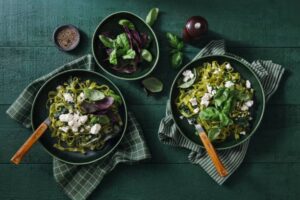Pasta is an adaptable food, suitable for people of different diets to enjoy.
Pasta takeaway near me refers to both dried and fresh products. There are many shapes of pasta available with some having very specific names.
Origin
 Pasta may seem to be synonymous with Italian cuisine, but its roots go much deeper. Dating back thousands of years and found across cultures worldwide, pasta’s diverse roots speak for themselves.
Pasta may seem to be synonymous with Italian cuisine, but its roots go much deeper. Dating back thousands of years and found across cultures worldwide, pasta’s diverse roots speak for themselves.
McGee asserts that noodles have existed since 3000 BCE in China, traveling westward and becoming popular foods throughout Europe where durum wheat was grown. Due to its affordability, ease of storage and versatility, pasta became an integral part of Italian life.
Many believe Marco Polo brought pasta back from his travels in China, but this story is mostly fictional. Pasta arrived in the Mediterranean long before Polo left on his voyage; historians also know noodles were traditionally boiled during this time; references can be found in Talmudic literature from around 5th century BCE as evidence of this technique.
Types
Pasta comes in many shapes, sizes and colours and is used in soups, casseroles, sauce-based recipes as well as part of salads or cold as salads. You may enjoy topping it off with butter and cheese before stuffing with meat, spinach, or other vegetables as well as seafood or beans; or eating it cold for lunches and snacks! Fresh varieties must be refrigerated while dry varieties remain shelf stable over long periods.
Estimates suggest there may be over 1000 varieties of pasta. They can be divided into families according to shape, length and thickness – such as Arabic itrija and Indian sev or seviyan, Italian tagliatelle (cutting), Asian vermicelli and short pastas like fettuccine and lasagna.
Pasta takeaway near me can provide an effective source of slow release energy, but should be eaten within a healthy eating pattern. Consuming it excessively could provide empty calories without essential nutrition; adding whole grains like pasta into your diet could help create a more balanced eating pattern.
Preparation
Pasta can be part of a healthy eating lifestyle when consumed in moderation, pairing it with lean proteins and vegetables for maximum nutritional benefit.
Quality pasta depends upon both the physical properties of its raw materials and processing steps: dosing and mixing, kneading, and shaping (by extrusion or sheeting) before drying. Durum wheat semolina pasta quality is heavily determined by its level of hydration.
Hydration levels depend upon particle size distribution and damaged starch accumulation. Therefore, in order to guarantee adequate protein hydration levels it is crucial to use semolina with low extraction rate and medium-to-large particle sizes for optimal protein hydration.
Dietary fibre has an adverse impact on redesigned pasta due to its hydrophilicity; as it decreases water available for hydration of gluten proteins and hinders their organisation into an even network, making the pasta difficult to form into continuous layers. Therefore, pasta-functionalisation strategies must be devised in order to overcome such drawbacks.
Cooking
Pasta takeaway near me is one of the world’s most versatile foods, providing comforting comfort food or delicious vegetarian entree. Pasta consumption trends reflect changes in health and nutrition guidelines as well as new flavours, colours and shapes becoming available to consumers. While pasta is immensely versatile in its use, its quality depends on several processing variables including dough rheological characteristics and cooking behaviours that impact quality control processes.
Hydration of semolina and its distribution within pasta are vital to its quality. Insufficient hydration leads to low mechanical resistance and poor cooking performance; excessive hydration increases cooking losses.
Ideal hydration of dough refers to an equilibrium between high water absorption and excellent pasta rheological properties such as elasticity and deformation resistance. However, cooking pasta also depends on its conditions for drying.